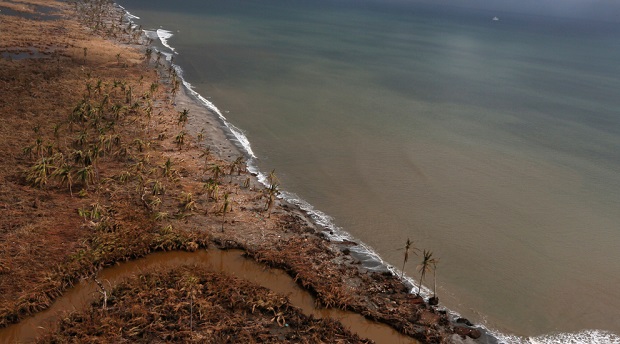Australians return to Leyte to enshrine their war heroes
PALO, Leyte—Seventy years ago, the first ever kamikaze (suicide) bombing in history happened as a Japanese pilot crashed his crippled aircraft into an Australian warship off the coast of Leyte province, resulting in the death of 30 Australian servicemen.
The 30 members of the Royal Australian Navy (RAN) killed and the 64 others wounded were on war duty aboard the battle cruiser HMAS (Her Majesty’s Australian Ship) Australia. They were assisting the Allied invasion of Leyte when attacked by a Japanese suicide aircraft on Oct. 21, 1944.
The names of the 30 casualties will be added to those of 62 other Australian servicemen killed in the Philippines during World War II on a new war memorial to be unveiled here Sunday afternoon.
“It is hard to find words to describe those young Australians who paid with their lives in defending the values [that] Australians hold dear … to ensure that the Filipino people were again free,” Australian Ambassador to the Philippines Bill Tweddell said.
The unveiling of the new war memorial will happen on the eve of the 70th anniversary of the Leyte landings, marking the return of Gen. Douglas MacArthur and the Allied forces to liberate the Philippines from the Japanese on Oct. 20, 1944.
Emile Dechaineux
One of those to be memorialized is Emile Dechaineux, captain of the Australia. Dying from a gaping wound in his stomach, Dechaineux continued to bark orders to his officers and sailors as hell broke loose, according to Australian war records.
For giving his life to the Allied cause, the Americans posthumously awarded Dechaineux with the Legion of Merit and, in 1990, the Australian government named a submarine—the Collins-class HMAS Dechaineux—in his honor.
“It was the first of the kamikazes,” recalled RAN Commodore John Collins, writing for the Naval Historical Review of Australia in January 1972.
One of the wounded in that attack, Collins survived and rose to become vice admiral in the RAN and was knighted by Queen Elizabeth II in 1951.
He died on Sept. 3, 1989, at age 90. A new fleet of combat submarines, including the Dechaineux, now bears his name.
New era in sea warfare
The attack on the Australia would mark a new era in warfare at sea and introduce the word “kamikaze” into human consciousness.
According to Wikipedia, kamikaze literally means “divine wind.” It is derived from the name of the storm that destroyed the fleet of the invading Mongol Army sent by Kublai Khan in 1281.
Embracing the ancient code of the Bushido warriors, the Japanese pilots—vowing to die for their emperor than be captured—deliberately crashed their aircraft into Allied warships, inflicting heavy damage.
Least known
That early morning attack— one of the least known episodes of the war in the Pacific—signaled the start of the Battle of Leyte Gulf, considered by war historians the greatest naval battle in history.
The decisive battle—showing the military superiority of the Allied powers—broke the back of the Japanese armada and crippled Japan’s military might, finally turning the tide in favor of the Allied forces.
Fought from Oct. 23 to 26, 1944, the battle resulted in more than 12,500 casualties for the Japanese forces, 2,800 for the Americans and close to 100 for the Australians.
Filipino guerrillas
It was in the Battle of Leyte Gulf that Japan lost one of its two dreadnoughts, the 65,000-ton Musashi.
An estimated 19 torpedo and 17 bomb hits from American carrier aircraft sank the Yamato-class battleship on the second day of battle, breaking the morale of the Japanese Navy.
Assisting the Allied invasion on the ground were the local guerrillas headed by Macrohon native Ruperto Kangleon and his “Black Army.”
There is no official count of the Filipino casualties, according to various war archives.
Proud of them all
In an e-mail interview with the Inquirer, Tweddell said he was proud of all the brave Australians—about 4,000 of them—who took part in the liberation of the Philippines.
“It is a matter of great pride to me that fine young Australian service personnel have been there for the people of the Philippines in their time of need,” Tweddell said.
Tweddell, together with Australian Defense Attaché Col. Bruce Murray and Assistant Defense Attaché Lt. Col. Tim Lopsik, will join officials from the Department of National Defense, Philippine Veterans Affairs Office and Armed Forces of the Philippines during the unveiling ceremonies.
Australian memorial
The memorial is located a few steps from the MacArthur Leyte Landing Memorial on Red Beach in Barangay Candahug here, where there is a shrine to the landing with oversized statues of MacArthur, President Sergio Osmeña and Brig. Gen. Carlos P. Romulo on a small pond.
According to Australian embassy officials in Manila, there are only a few World War II veterans left from their country and they are not aware of anybody making the customary nostalgic trip to this town this year.
The 4,000 Australian servicemen who took part in the liberation have dwindled to a few hundreds and they are now 90 years old or older, the same officials said.
Recognized after 70 years
It took Australian authorities 70 years to recognize 92 of their war dead in the Pacific but now, those men’s gallantry and heroism will finally be etched in stone.
“I am delighted that through the construction of this memorial, we can finally recognize their contribution to the land they fought to liberate,” Murray, the defense attaché, told the Inquirer.
Palo Mayor Remedios Petilla and her son, Leyte Gov. Leopoldo Dominico Petilla, will join the Australian diplomats and other local and foreign dignitaries for the unveiling rites.
RELATED STORIES
Japanese forces back in Leyte Gulf
Fil-Ams to celebrate 70th anniversary of Leyte landing by US forces
Aussie firm to start oil drilling in Leyte town
